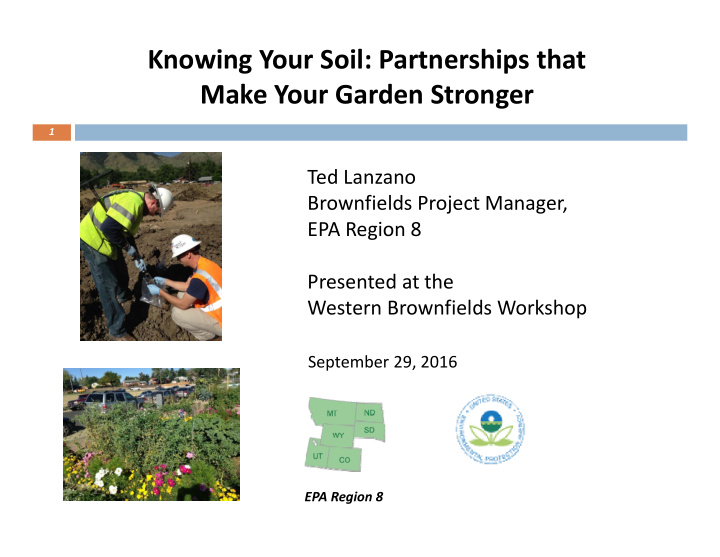



Knowing Your Soil: Partnerships that Make Your Garden Stronger 1 Ted Lanzano Brownfields Project Manager, EPA Region 8 Presented at the Western Brownfields Workshop September 29, 2016 EPA Region 8
Denver Urban Gardens (DUG) DUG manages over 150 gardens throughout Denver. • Production exceeds 540 tons of produce per year. • The gardens beautify urban neighborhoods, improve soils, • strengthen communities and generate fresh produce for people who need it most. DUG supports the entire process of developing a community garden • including design, technical assistance, training and managing the produce.
DUG and EPA’s Partnership Through the Targeted Brownfields Assessment (TBA) program, EPA • tests DUG’s new or expanded gardens for contaminants. An EPA Toxicologist reviews results and provides an interpretation • on the suitability of the site as a garden So far, all 16 properties that have been tested have received the • “green light” for gardening.
Targeted Brownfields Assessments (TBAs) EPA provides environmental assessment services free of • charge to communities through the TBA program. TBAs typically consist of Phase I and II assessments and • cleanup planning Assessments conducted by an EPA contractor. • Ongoing application process • Easy application and quick turnaround time • Available nationwide • States also provide TBAs •
Steps before gardening on a vacant lot • 5 Meet with the community garden group or school to • discuss project goals and data needs Identify previous uses • Review future garden design • Develop sampling and analysis plan • Perform sampling, interpret • results, provide report and debrief to garden group Cleanup, if necessary • Implement Best Management Practices • Begin gardening! •
Best Management Practices (BMPs) 6 Top soil, compost and other soil amendments from certified • sources. Alternative methods that do not involve growing plants directly • in the ground such as raised beds, container gardening and greenhouses. Cover existing soil, walkways and other areas that did not • receive amendments with mulch and landscape fabric. Hedges and fencing to reduce road and other windblown • contamination.
Incremental Sampling 7 Type of sampling that provides a representative or average concentration of • the contaminant levels. Involves identifying a discrete area of a property called a “decision unit” and • taking composite samples within the decision unit at varying depths. Typical depth profiles for garden sites: • 1 ‐ 2” • 2 ‐ 6” • 6 ‐ 12” • 12 ‐ 18” • Samples from each decision unit and depth are mixed and sent to lab. • Cost effective • Consistent and reproducible data •
Asia Pacific Development Center (APDC) Scrap yard/ auto repair Dry cleaner with known Former gas Auto Heavy traffic release station 8 repair 8
Asia Pacific Development Center (APDC) Phase II assessment tested for • volatile organic compounds (VOCs), semivolatile organic compounds (SVOCs), pesticides, petroleum, metals and soil pH. Results came back clean, • which helped facilitate a new garden.
Triangle Park • Contamination concerns from former gas station, heavy traffic and unknown historic uses. • The park had also become a haven for drug deals and was featured on Drugs, Inc. • Denver Parks and Recreation closed Triangle Park and partnered with DUG and EPA to test the soil so it could be reused as a community garden. 10 1
Triangle Park Phase II assessment tested for • diesel and gas range organics (DRO/GRO), VOCs and metals. Results came back clean and • park construction began. Impressive transformation of • a former drug haven into a thriving community garden!
Brownfields to food co ‐ ops, farmer’s markets and greenhouses Burns Street Nutrition Center, Missoula, Montana 12 1
Community Garden Cautionary Tale? Sacramento, California Garden for over 30 years • Tested, found lead, PAHs, • pesticides 1,900 yd 3 soil, 24 ‐ 48 inches • removed $423,000 leveraged for • cleanup/ garden US EPA, Office of Brownfield and Land Revitalization 13
Brownfields and Urban Ag web page Accessed from EPA’s main • Brownfields page: www.epa.gov/brownfields Urban Farm Business Plan Handbook • Brownfields and Urban Agriculture: • Interim Guidelines for Safe Gardening Practices Excellent source of information from • other federal agencies, states and non ‐ profits from around the country. 14
Thank you! 15 Feel free to contact me with questions • Ted Lanzano • (303) 312 ‐ 6596 • lanzano.ted@epa.gov EPA’s national urban garden coordinator: • Ann Carroll • (202) 566 ‐ 2748 • carroll.ann@epa.gov
Recommend
More recommend